Main content starts here.
Foreign Languages > Chiba International Information Square - To foreign residents - > Chiba Nanohana News > Chiba Nanohana News (Past Issues) > Chiba Nanohana News (December 2023)
Chiba Nanohana News (December 2023)
Index
I. News II. Festivals and Events
I. News
1) International Understanding Seminar Event Details and Call for Attendees
Chiba Prefecture will hold the annual “International Understanding Seminar” which aims to deepen residents’ understanding of the creation of a multicultural, coexisting society.
The seminar will consist of two parts: a panel discussion by five panelists with roots overseas, and a lecture by Ms. Hori Hisano, an advocate for labor support and the promotion of Japanese language education.
<Details>
1. Panel discussion (80 minutes)
Ms. Hori Hisano will facilitate the discussion on work and community involvement with five residents of Chiba Prefecture with overseas roots.
Panelists
- Chee En Jia (Singapore; Coordinator for International Relations, Chiba Prefectural Government)
- Cesar Cabrejos (Peru; translation agency)
- Tarek Fatyani (Syria; IT-related enterprise CEO)
- Nakamura Yurika (China; Shukutoku University)
- Chekhovska Yuliia (Ukraine; Chiba Municipal Inage Senior High School)
Facilitator
- Hori Hisano, representative director of Global Human Talent Support Hamamatsu
2. Lecture (30 minutes)
Ms. Hori Hisano will reflect on the panel discussion and talk about how we can understand diverse values and create a coexisting society where everyone can contribute and be involved.
Theme: Glocalizing and Making Chiba More Attractive – Multiculturalism in the Workplace and Community
- Date and Time: 28 January 2024 (Sunday), 2 p.m. – 4.20 p.m.
- Venue: Chiba Prefecture Education Center New Wing, Large Hall (4-13-10 Chuo, Chuo-ku, Chiba City)
- Organizers: Chiba Prefecture, Chiba International Center
- Capacity: first 300 sign ups
- Admission: free
- How to sign up:
- Via the Chiba Prefectural Government website.
- Via email. Please send the email in the following manner.
To: kokusaig3@mz.pref.chiba.lg.jp
Subject: Sign up for the International Understanding Seminar
a) Names of all the attendees
b) The representative’s email address
c) The representative’s telephone number
- Inquiries: Chiba Prefecture International Affairs Division Tel.:043-223-2436
*This seminar will be conducted in Japanese only.
*Please do not attend this seminar if you have a fever or are feeling unwell.
II. Festivals and Events
1) Hatsuhinode in Chiba
Kick off a great new year with a stunning start!
Watching a beautiful sun rise magnificently over the horizon in Chiba on the very first day of the year is a sure way to start your year right.
1. Cape Inubo (Choshi City)
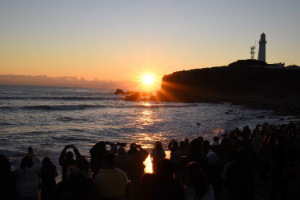
The earliest sunrise in the whole of Japan* occurs at around 6: 46 a.m. at Cape Inubo, the eastern most tip of the Kanto region.*excluding mountain summits and outlying islands.
Seeing the first sunrise brings good fortune and this is just the place to do so before everyone else! Make your New Year’s wish as the sun rises over the ocean!
- Location: Cape Inubo, Choshi City
- Access: 10-minute walk from Inubo Station (Choshi Electric Railway)
- Inquiries: Choshi City Tourism Association TEL: 0479-22-1544
2. Yakata Beach and Kidohama Beach (Yokoshibahikari Town)
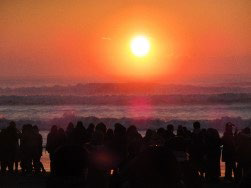
Celebrate the New Year by watching the magnificent sun emerge from the horizon on the Pacific Ocean at Yakata Beach and Kidohama Beach!
- Location:
- Yakata Beach: Yakata, Yokoshibahikari Town, Sanbu District
- Kidohama Beach: Kido, Yokoshibahikari Town, Sanbu District
- Access:
- To Yakata Beach:
15-minute taxi ride from Yokoshiba station (JR Sobu Main line)
20-minute drive via Hasunuma from Matsuo Yokoshiba IC on the Ken-o Expressway - To Kidohama Beach
15-minute drive on the Choshi Renraku Road from Yokoshibahikari IC
- Inquiries: Yokoshibahikari Town Tourist Association
 TEL: 0479-74-8585
TEL: 0479-74-8585
3. Maebara-Yokosuka Beach (Kamogawa City)
Enjoy the first sunrise of the year along this beautiful coastline that was chosen as one of “Japan’s Top 100 Beaches.” The grand waves, typical for the outer coastline of Chiba, are popular with surfers for their first surf of the year. For non-surfers, Maebara Promenade is perfect for a New Year’s Day walk with its tropical ambience created by the palm trees lining the beach.
- Location: Maebara or Yokosuka, Kamogawa City
- Access: 5-minute walk from Awa-Kamogawa Station (JR Sotobo Line)
- Inquiries: Kamogawa City Commerce and Tourism Division TEL: 04-7093-7837
4. Minami Chikura Beach (Minamiboso City)
With white sands and clear water, this beautiful beach is highly popular with surfers. A prayer ritual for peace and blessings will be performed at this beach with the first rising of the sun. This event is witnessed by many locals and tourists every year.
- Location: Minami-asai, Chikura-cho, Minamiboso City
- Access: From Chikura station (JR Uchibo line), take the Nitto bus bound for Shirahama, alight at Minami-Chikura, and walk for 3 minutes
- Inquiries: Minamiboso City Tourism Association Chikura Tourist Information Center TEL: 0470-44-3581
5. Odayama Park (Kisarazu City)
Kisarazu Tower at the peak of Odayama Park, also affectionately known as Forest of Love, is a very romantic spot.
Not only can you see the whole of Kisarazu City, you can also see the Aqualine and even Sky Tree in Tokyo.
- Location: 2-16 Oda, Kisarazu City
- Access: From the East exit of Kisarazu station (JR Uchibo line), take the Ota Junkan bus, alight at Koi no Mori bus stop and walk for 5 minutes.
- Inquiries: Kisarazu City Urban Development Division TEL: 0438-23-8467
2) Hatsumode in Chiba
Seen the first sunrise of 2024 and ate traditional New Year’s fare? Wrap up your Japanese O-shogatsu (New Year) experience with hatsumode, the first shrine or temple visit of the year. Here are some places to enjoy the festivities.
1. Inage Sengen Shrine (Chiba City)
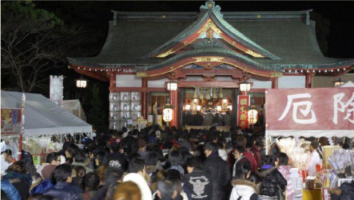
Known as the god of safe childbirth and child-raising, Inage Sengen Shrine is also effective for good fortune and protection from misfortune, safety for one’s family, and business prosperity. Approximately 300,000 people visit the shrine every year over the first three days of the New Year.
12 Kagura dances (intangible cultural property of Chiba Prefecture) will be performed at the shrine starting from 1 p.m. on New Year’s Day.
- Location: 1-15-10 Inage, Inage-ku, Chiba City
- Access: 15-minute walk from Inage station (JR Sobu Line) or 4-minute walk from Keisei Inage station (Keisei Line)
- Inquiries: Inage Sengen Shrine
 TEL: 043-245-7777
TEL: 043-245-7777
2. Katsushika Hachimangu Shrine (Ichikawa City)
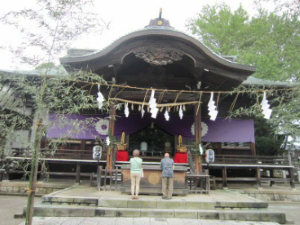
This shrine was established by Emperor Uda during the Kanpyo Era (889~896 CE) as an offshoot of Iwashimizu Hachiman in Kyoto. Since then, the shrine gained religious following with members of the court and military commanders, including Tokugawa Ieyasu.
To the right of the honden (main sanctuary) stands a national-designated natural monument, the Senbon Icho, a ginkgo tree that is estimated to be at least 1200 years.
- Location: 4-2-1 Yawata, Ichikawa City
- Access: 8-minute walk from the north exit of Motoyawata station (JR Sobu Line) or 5-minute walk from Keisei Motoyawata station (Keisei Line)
- Inquiries: Katsushika Hachimangu Shrine TEL: 047-332-4488
3. Naritasan Shinshoji Temple (Narita City)
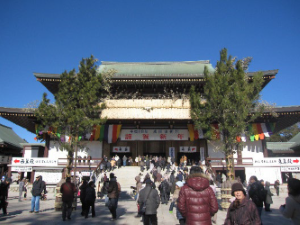
Known nationwide as the O-fudo-sama (Acala, the immovable protector) of Narita, this temple is the headquarters of the Shingonshu chisan sect which sees around 3 million visitors over the first three days of the year, the largest number of visitors to a temple within Japan.
Five national-designated important cultural properties lie within the temple ground, including a three-tiered pagoda that was erected in the Edo period. Io-den was constructed in 2017 to celebrate the 1080th anniversary of the laying of the foundation in Naritasan.
Don’t forget to also visit Naritasan Park and take in the seasonal beauty of this 165,000-square-meter Japanese garden.
- Location: 1 Narita, Naria City
- Access: 10-minute walk from Keisei Narita station (Keisei Line) or Narita station (JR Narita Line)
- Inquiries: Naritasan Shinshoji Temple TEL: 0476-22-2111
4. Katori Jingu Shrine (Katori City)
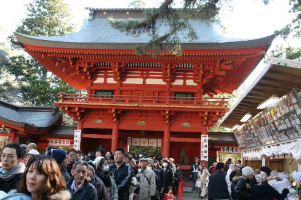
Futsunushi no Okami, who is revered as the country’s guardian deity is enshrined in this shrine. This is the highest-ranking shrine in the Kazusa province and is one of only a few shrines in Japan conferred with the title of “jingu”, which indicates its ties to the Imperial Family.
The honden (sanctuary) and romon (gate) are designated national important cultural properties, and the haiden (worship hall) is a registered cultural property. Many cultural properties, including a national treasure, the Kaiju Budo Kyo mirror, are displayed in the treasure vault.
Many people visit to pray for safe travels, safety for one’s family, business prosperity, protection from misfortune, and wish fulfilment.
- Location: 1697-1 Katori, Katori City
- Access: 10 minutes by taxi from Sawara station (JR Narita Line) or 30-minute walk from Katori station (JR Narita Line)
- Inquiries: Katori Jingu Shrine
 TEL: 0478-57-3211
TEL: 0478-57-3211
5. Awa Shrine (Tateyama City)
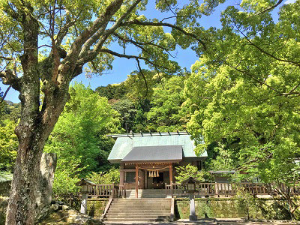
According to ancient records, Awa Shrine has a long history beginning from as far as 2670 years ago.
The shrine is often visited for safe travels, good fortune, protection from misfortunes, safety for one’s family, and business prosperity.
- Location: 589 Daijingu, Tateyama City
- Access: From the east exit of Tateyama station (JR Uchibo Line), take the JR bus bound for Awa-Shirahama via Awa-Kanbe, and 5 minutes from Awa Jinja-mae bus stop
- Inquiries: Awa Shrine TEL: 0470-28-0034
6. Takebe Shrine (Minamiboso City)
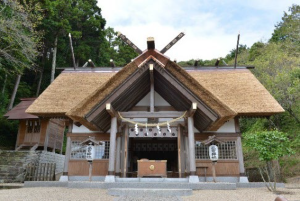
Takabe Shrine is the only shrine in Japan where the god of cooking, Iwakamutsukari no Mikoto is enshrined. Iwakamutsukari no Mikoto is also well-known as the god of miso and soy sauce and is revered by chefs and others working in the food industry.
O-harae-shiki and Joya-sai, purifying rituals to cleanse oneself of the pollution and misfortunes will occur at 11.30 p.m. on New Year’s Eve, and the New Year rituals begins at 12 midnight.
- Location: 164 Minami-asai, Chikura-cho, Minamiboso City
- Access:
【By Train】From Chikura station (JR Uchibo Line), take the Nitto bus bound for Shirahama and walk for 10 minutes from Takabe Jinja Iriguchi bus stop or Chikura-bashi bus stop
【By Car】16km drive from Tomiura IC on the Futtsu-Tateyama Expressway - Inquiries:
Takabe Shrine Office TEL: 0470-44-5625
Minamiboso City Tourism Association Chikura Tourist Information Center TEL: 0470-44-3581
7. Kanozan Jinyaji Temple (Kimitsu City)
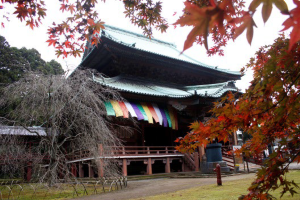
Situated at the peak of Mount Kano which is known as the mountain of religious faith and legends, this temple is said to have been founded by Price Shotoku and is the oldest temple in the Kanto region.
The temple grounds, surrounded by towering Japanese cedar trees, consists of several architectural structures including the Ni-o gate, the main sanctuary, the sacred text repository, a hexagonal hall, the bell tower, and a five-tiered stone pagoda. You can also admire carvings created by Unkei and Hidari Jingoro at this time-honored temple.
The first 108 people to purchase a ticket (1000 yen each) will be able to ring the temple bell from 11 p.m. on 31 December (Saturday).
- Location: 324-1 Kanozan, Kimitsu City
- Access:
【By Train】From Sanukimachi station (JR Uchibo Line), take the bus bound for Kanozan until the last stop
*No bus service from January 1-3.
【By Car】From Kimitsu IC on the Futtsu-Tateyama Expressway, 25 minutes on Prefectural Road 92 towards Kamogawa, passing through Higashiawagura - Inquiries: Jinyaji Temple
 TEL: 0439-37-2351
TEL: 0439-37-2351
